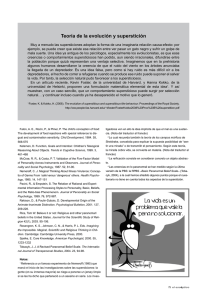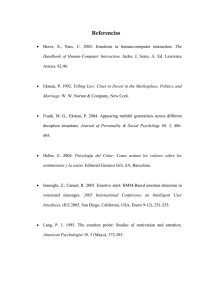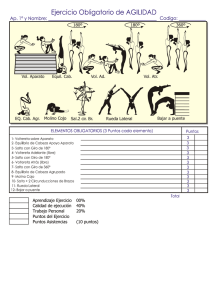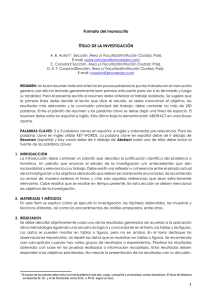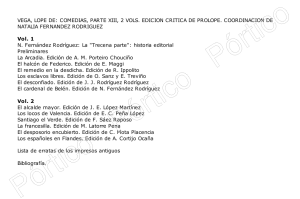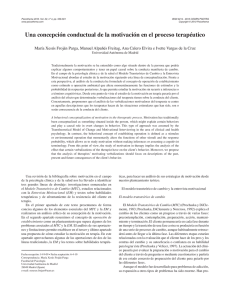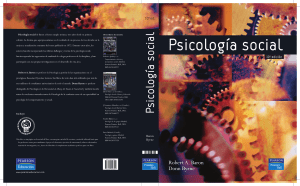en otra ventana
Anuncio
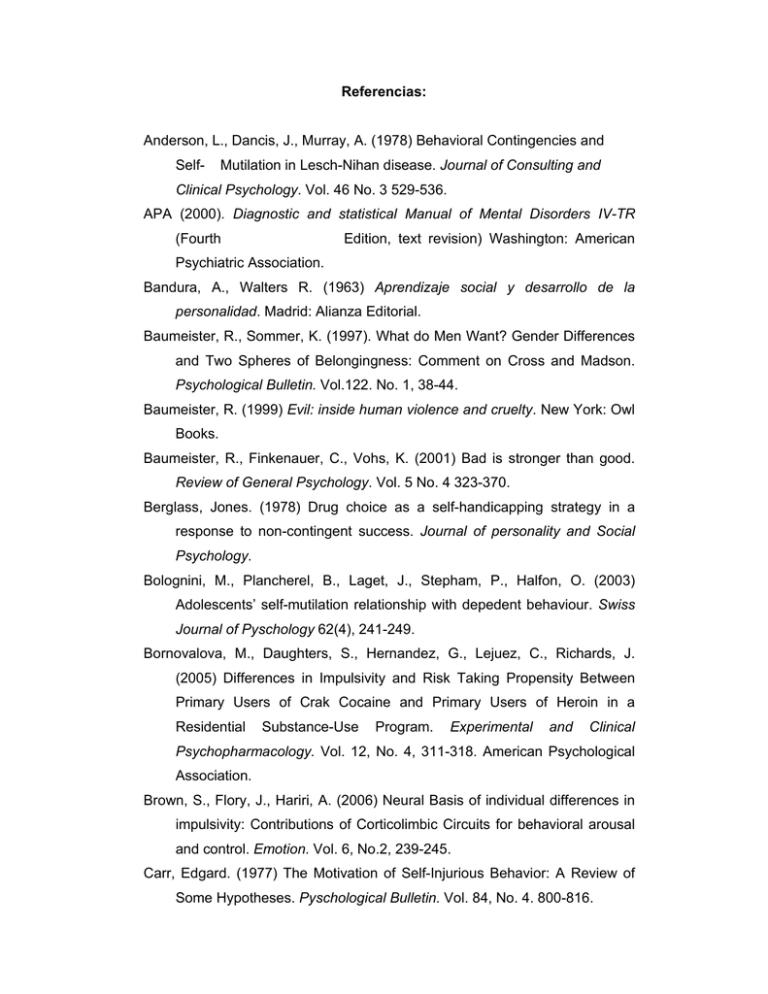
Referencias: Anderson, L., Dancis, J., Murray, A. (1978) Behavioral Contingencies and Self- Mutilation in Lesch-Nihan disease. Journal of Consulting and Clinical Psychology. Vol. 46 No. 3 529-536. APA (2000). Diagnostic and statistical Manual of Mental Disorders IV-TR (Fourth Edition, text revision) Washington: American Psychiatric Association. Bandura, A., Walters R. (1963) Aprendizaje social y desarrollo de la personalidad. Madrid: Alianza Editorial. Baumeister, R., Sommer, K. (1997). What do Men Want? Gender Differences and Two Spheres of Belongingness: Comment on Cross and Madson. Psychological Bulletin. Vol.122. No. 1, 38-44. Baumeister, R. (1999) Evil: inside human violence and cruelty. New York: Owl Books. Baumeister, R., Finkenauer, C., Vohs, K. (2001) Bad is stronger than good. Review of General Psychology. Vol. 5 No. 4 323-370. Berglass, Jones. (1978) Drug choice as a self-handicapping strategy in a response to non-contingent success. Journal of personality and Social Psychology. Bolognini, M., Plancherel, B., Laget, J., Stepham, P., Halfon, O. (2003) Adolescents’ self-mutilation relationship with depedent behaviour. Swiss Journal of Pyschology 62(4), 241-249. Bornovalova, M., Daughters, S., Hernandez, G., Lejuez, C., Richards, J. (2005) Differences in Impulsivity and Risk Taking Propensity Between Primary Users of Crak Cocaine and Primary Users of Heroin in a Residential Substance-Use Program. Experimental and Clinical Psychopharmacology. Vol. 12, No. 4, 311-318. American Psychological Association. Brown, S., Flory, J., Hariri, A. (2006) Neural Basis of individual differences in impulsivity: Contributions of Corticolimbic Circuits for behavioral arousal and control. Emotion. Vol. 6, No.2, 239-245. Carr, Edgard. (1977) The Motivation of Self-Injurious Behavior: A Review of Some Hypotheses. Pyschological Bulletin. Vol. 84, No. 4. 800-816. Cattell, R. (1972) El análisis científico de la personalidad. Barcelona: Editorial Fontanella. Cattell, R., Eber, H., Tatsuoka, M. Cuestionario de 16 factores de la personalidad. México, D.F.: Editorial Manual Moderno. Cooper, L., Wood, P., Orcutt, H., Albino, A. (2003) Personality and the predisposition to engage in risky or problem behaviors during Adolescence. Journal of Personality and Social Psychology. Vol. 84, No.2 390-410. Cross, S., Madson, L. (1997). Models of the Self: Self Construals and Gender. Psychological Bulletin. 122, 5-37. Cyders, M., Smith, G., Spillane, N., Fischer, S., Annus, A., Peterson, C. (2007). Integration of Impulsivity and Positive Mood to Predict Risky Behavior: Development and Validation of a Measure of Positive Urgency. Psychological Assessment. Vol.19 No.1, 107-118. American Psychological Association 2007. Domjam, M. (1999) Principios de Aprendizaje y Conducta. México. Thomson Editores Ewen, R. (1993) An introduction to theories of personality. New Jersey: Lawerence Erlbaum Associates, Publishers. Favell, J., McGimsey, J., Schell, R. (1982) Treatment and self-injury by providing alternate sensory activities. Analysis and intervention in developmental disabilities 83-104. Freud, S. (1920) Más allá del Principio del Placer. (Vol. 18) Argentina: Amorrortu Editores Gratz, Kim. (2006) Risk Factors for Deliberate Self-Harm Among Female College Students: The Role and Interaction of Childhood Maltreatment, Emotional Inexpressivity, and Affect Intensity/Reactivity. American Journal of orthopsychiatry. Vol. 76, No. 2 238-250. Hall, C., Gardner, L. (1970) La teoría del estímulo-respuesta y la personalidad. Buenos Aires: Editorial Paidós. Herrnstein, R. (1961). Relative and absolute strength of response as a function of frequency of reinforcement. Journal of the Experimental Analysis of Behavior, 4, 267-272. Hjelmeland, H., Groholt, B. (2005) A comparative Study of Young and Adult deliberate Self-Harm patients. Crisis 2005. Vol. 26(2) 64-72. Horn, N., Dolan, M., Elliott, R. Deakin, J., Woodruff, P. (2003). Response inhibition and impulsivity: an FMRI study. Neuropsychologia. 41, 19591966. Huerta, A. (2004) Ley de Igualación y la conducta autodestructiva. Tesis inédita para obtener título de licenciatura en Psicología. Kelley, K. (1985). Conceptualizing Chronic Self-Destructiveness (Reporte No. CG18457) Williamsburg, paper presented at an invited address at the college of William and Mary. (Eric, Servicio de reproducción de documentos NO. ED261268). Kelley, K. (2001). Chronic Self-Destructiveness and Locus of Control in Cross Cultural Perspective. The Journal of Social Psychology. 126(5) 573-577. Mahrer, A. (1956) The role of expectancy in delayed reinforcement. Journal of Experimental Psychology. 52 101-106 Maldonado, O. (2003) Valor subjetivo de las recompensas demoradas e inmediatas y su relación con conductas autodestructivas. Tesis inédita para obtener título de licenciatura en Psicología. Maslow, A. (1968). The farther reaches of human nature. New York: Viking Pres 1971. Luiselli, Matson, Singh (1992). Self-Injurious Behavior: Analysis, Assesment and Treatment. U.S.A. Springer Verlag. Martin, Pear. (1999). Modificación de la conducta. Madrid: Editorial Prentice Hall. Menninger, K. (1938) Man against himself. London: R. Hart Davis. Meyerson, L., Kerr, N. Michael, J. (1967) Behavior modification in rehabilitation. Child Development Readings in experimental analysis. New York: Appleton-Century-Crofts. Muehlenkamp, J. (2005) Self-Injurious Behavior as a Separate Clinical Syndrome. American Journal of Orthopsychiatry. Vol. 75, No. 2, 324-333. Nock, M.; Prinstein, M.(2004) A Functional Approach to the Assesment of Self-Mutilative Behavior. Journal of Consulting and Clinical Psychology. Vol. 72, No. 5, 885-890. Ramírez, Mónica (1998). Autoconcepto, Percepción del Funcionamiento Familiar y Conductas Autodestructivas en Universitarios. Tesis inédita para obtener el título de Licenciatura en Psicología. Romanczyk, R., Goren, E. (1975). Case Studies: Severe Self-Injurious Behavior: The problem of Clinical Control. Journal of Consulting and Clinical Psychology. Vol. 43, No. 5, 730-739. Seligman, Martin (1975). Indefensión. Madrid: Editorial Debate. Scher, S., Baumeister, R.F. (1988) Self Defeating behavior patterns among normal individuals: Review and analysis of common self-destructive tendencies. Psychological Bulletin. Sharp, Michelle; Schill, Thomas (1995). Chronic Self-Destructiveness and self-Defeating Personality: Similarities and Differences. Journal of Personality Assessments. 64(2) 270-278. Lawrence Erlbaum Associates Inc. Simeon, D., Favazza, A. (2001). Self-injurious behaviors: Phenomenology and assessment. In D. Simeon & E. Hollander (Eds). Self-injurious behaviors: Assesment and treatment (pp.1-28). Washington, DC: American Psyquiatric Publishing. Tart, C. (1979). Ciencia, estados de conciencia y experiencias espirituales: la necesidad de ciencias específicas de estado. Psicologías transpersonales. Buenos Aires: Paidós. Tate, B., Barroff, G., (1966). Aversive control of self-injurious behavior in a psychotic boy. Behavior research and Therapy, 4, 281-287 Van der Linden, M., D’Acremont, M., Zermatten, A., Jermann, F., et al. (2006) A french adaptation of the UPPS Impulsive behavior scale. European Journal of Psychological Assessment. Vol 22(1): 38-42. Villanueva. M.A. (1988). Más allá del principio de la autodestrucción. México: El manual moderno. Whiteside, S.P., Lynam, D.R. (2001). The Five factor model and impulsivity: Using a structural model of personality to understand impulsivity. Personality and individual differences, 30, 669-689. Zuckerman, M., Kuhlman, M., Joireman, J., Teta, P., Kraft, M. (1993) A comparison of Three structural models for Personality: The Big Three, the Big Five, and the alternative Five. Journal of Personality and Social Psychology. Vol. 65, No. 4 757-768.
